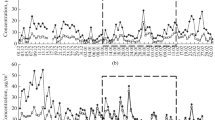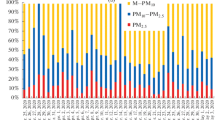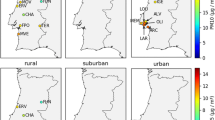Abstract
Data from continuous observations of aerosol composition in the surface atmosphere in Moscow (in the city center) and in Moscow oblast (near the city of Zvenigorod) for three years, from the fall of 2019 to the end of 2022, are analyzed. The data were compared with the results of observations at the Moscow network of stations of the State Budgetary Institution Mosecomonitoring. The concept of conditional background aerosol pollution of the near-surface atmosphere in Moscow has been introduced for those days when the daily mean mass concentration of PM10 particles was below the maximum permissible concentration (MPC) (60 μg/m3). The number of such days exceeded 91% in Moscow over three years of observations. Previously, the authors found that all episodes of higher aerosol pollution of urban air (exceeding the MPC) are associated either with the presence of a close local source in the city or with the long-distance transport of combustion aerosols and/or dust to Moscow and its suburbs from other regions. The daily mean concentration of PM2.5 in the city and the suburb is year-round below the MPC (35 μg/m3). The conditional background aerosol pollution of the surface atmosphere is formed by both natural and anthropogenic sources of aerosols, not only of local, but also of remote origin. Its level and composition implicitly reflect the influence of meteorological parameters on the sources and sinks of aerosols and also the influence of advective transport of aerosol by air masses to and from the city. The results of analysis of seasonal variations in various indicators of aerosol composition in the surface atmosphere under conditional background pollution are presented: the mass concentration of PM10 and PM2.5 particles and individual chemical elements and the distribution of chemical elements by size of aerosol particles. Similarities and differences between these characteristics in the surface air of the city and the suburb in different seasons are specially emphasized.









Similar content being viewed by others
REFERENCES
Andronova, A.V., Iordanskii, M.A., Trefilova, A.V., Lebedev, V.A., Minashkin, V.M., Obvintsev, Yu.I., Artamonova, M.S., and Granberg, I.G., Comparative analysis of pollution of the surface atmospheric layer in such megalopolises as Moscow and Beijing, Izv., Atmos. Ocean. Phys., 2011, vol. 47, no. 7, pp. 819–827.
Bezuglaya, E.Yu. and Smirnova, I.V., Vozdukh gorodov i ego izmeneniya (Urban Air and Its Changes), St. Petersburg: Asterion, 2008.
Birger, M.I., Val’dberg, A.Yu., Myagkov, B.I., Padva, V.Yu., and Rusanov, A.A., Spravochnik po pyle- i zoloulavlivaniyu (Handbook of Dust and Ash Collection), Moscow: Energoatomizdat, 1983.
Bond, T.C., Doherty, S.J., Fahey, D.W., Forster, P.M., Berntsen, T., DeAngelo, B.J., Flanner, M.G., Ghan, S., Kärcher, B., Koch, D., Kinne, S., Kondo, Y., Quinn, P.K., Sarofim, M.C., Schultz, M.G., et al., Bounding the role of black carbon in the climate system: a scientific assessment, J. Geophys. Res.: Atmos., 2013, vol. 118, pp. 5380–5552.
Chapman, S., Watson, J.E.M., Salazar, A., Thatcher, M., and McAlpine, C.A., The impact of urbanization and climate change on urban temperatures: a systematic review, Landscape Ecol., 2017, vol. 32, pp. 1921–1935.
Chubarova, N.E., Androsova, E.E., and Lezina, E.A., The dynamics of the atmospheric pollutants during the Covid-19 pandemic 2020 and their relationship with meteorological conditions in Moscow, Geogr., Environ., Sustainability, 2021. https://doi.org/10.24057/2071-9388-2021-012
Dobrovol’skii, V.V., Biogeokhimiya mirovoi sushi. Izbrannye trudy (Biogeochemistry of the World Soil: Selected Works), vol. 3, Moscow: Nauchnyi mir, 2009.
Doklad “O sostoyanii okruzhayushchei sredy v gorode Moskve v 2022 godu” (Report on the Environmental State in Moscow for 2022), Kul’bachevskii, A.O., Ed., Moscow, 2023.
Ehrhardt, H., Röntgenfluoreszenzanalyse. Anwendung in Betriebslaboratorien, Leipzig: VEB Deutscher Verlag für Grundstoffindustrie, 1981; Moscow: Metallurgiya, 1985.
Elansky, N.F., Shilkin, A.V., Ponomarev, N.A., Zakharova, P.V., Kachko, M.D., and Polyakov, T.I., Spatiotemporal variations in the content of pollutants in the Moscow air basin and their emissions, Izv., Atmos. Ocean. Phys., 2022, vol. 58, no. 1, pp. 80–94. https://doi.org/10.1134/S0001433822010029
Ginzburg, A.S. and Demchenko, P.F., Anthropogenic meso-meteorological feedbacks: A review of a recent research, Izv., Atmos. Ocean. Phys., 2019, vol. 55, no. 6, pp. 573–590.
Ginzburg, A.S. and Dokukin, S.A., Influence of thermal air pollution on the urban climate (estimates using the COSMO-CLM model), Izv., Atmos. Ocean. Phys., 2021, vol. 57, no. 1, pp. 47–59.
Ginzburg, A.S., Gubanova, D.P., and Minashkin, V.M., Influence of natural and anthropogenic aerosols on global and regional climate, Russ. J. Gen. Chem., 2008, vol. 79, no. 9, pp. 2062–2070.
GN 2.1.6.3492-17, Maximum permissible concentrations (MPCs) of pollutants in the atmospheric air of urban and rural settlements: Hygiene standards as amended on May 31, 2018 by decree no. 37 of the Chief Public Health Officer of the Russian Federation, Moscow: Federal Center for Hygiene and Epidemiology of the Russian Federal State Agency for Health and Consumer Rights, 2019.
Gubanova, D.P., Belikov, I.B., Elansky, N.F., Skorokhod, A.I., and Chubarova, N.E., Variations in PM2.5 surface concentration in Moscow according to observations at MSU meteorological observatory, Atmos. Oceanic Opt., 2018a, vol. 31, no. 3, pp. 290–299.
Gubanova, D.P., Kuderina, T.M., Chkhetiani, O.G., Iordanskii, M.A., Obvintsev, Yu.I., and Artamonova, M.S., Experimental studies of aerosols in the atmosphere of semiarid landscapes of Kalmykia: 2. Landscape–geochemical composition of aerosol particles, Izv., Atmos. Ocean. Phys., 2018b, vol. 54, no. 10, pp. 1430–1448.
Gubanova, D.P., Vinogradova, A.A., Iordanskii, M.A., and Skorokhod, A.I., Time variations in the composition of atmospheric aerosol in Moscow in spring 2020, Izv., Atmos. Ocean. Phys., 2021a, vol. 57, no. 3, pp. 297–309.
Gubanova, D.P., Vinogradova, A.A., Skorokhod, A.I., and Iordanskii, M.A., Abnormal air pollution by aerosol in Moscow near a local anthropogenic source in July 2021, Gidrometeorol. Issled. Prognozy, 2021b, no. 4, pp. 133–147. https://doi.org/10.37162/2618-9631-2021-4-133-147
Gubanova, D.P., Iordanskii, M.A., Kuderina, T.M., Skorokhod, A.I., Elansky, N.F., and Minashkin, V.M., Elemental composition of aerosols in the near-surface air of Moscow: Seasonal changes in 2019 and 2020, Atmos. Oceanic Opt., 2021c, vol. 34, no. 6, pp. 475–482. https://doi.org/10.1134/S1024856021050122
Gubanova, D., Chkhetiani, O., Vinogradova, A., Skorokhod, A., and Iordanskii, M., Atmospheric transport of dust aerosol from arid zones to the Moscow region in the fall 2020, AIMS Geosci., 2022a, vol. 8, no. 2, pp. 277–302. https://doi.org/10.3934/geosci.2022017
Gubanova, D.P., Vinogradova, A.A., Iordanskii, M.A., and Skorokhod, A.I., Variability of near-surface aerosol composition in Moscow in 2020–2021: Episodes of extreme air pollution of different genesis, Atmosphere, 2022b, vol. 13, no. 4, pp. 574–599. https://doi.org/10.3390/atmos13040574
Gubanova D.P., Iordanskii M.A., Vinogradova A.A., Belikov I.B., Belousov V.A. Particle density values for numerical estimation of mass concentration of near-surface submicron and micron aerosol, Atmos. Oceanic Opt., 2023a, vol. 36, no. 6, pp. 670–684. https://doi.org/10.1134/S102485602306009X
Gubanova, D.P., Sadovskaya, N.V., Iordanskii, M.A., Avilov, A.S., and Minashkin, V.M., Morphology of surface aerosol particles in Moscow via scanning electron microscopy, Bull., 2023b, vol. 87, no. 10, pp. 1411–1416.
Gubanova, D.P., Vinogradova, A.A., and Sadovskaya, N.V., Brochosomes and other bioaerosols in the surface layer of the atmosphere of, Moscow metropolis, Atmosphere, 2023c, vol. 14, pp. 504–519. http://rp5.ru. http://www. windy.com/ru. https://english.mee.gov.cn/Resources/ standards/Air_Environment/quality_standard1/201605/ t20160511_337502.shtml. https://mosecom.mos.ru/ stations/. https://weatherarchive.ru/Pogoda/Moscow. https://www.eea.europa.eu/themes/air/air-quality-concentrations/air-quality-standards. https://www.mee. gov.cn/ywgz/fgbz/bz/bzwb/jcffbz/201203/t20120302_ 224166.shtml.https://doi.org/10.3390/atmos14030504
https://www.ready.noaa.gov/HYSPLIT.php.
Ivanov, V.V., Ekologicheskaya geokhimiya elementov: Spravochnik v 6 knigakh (Ecological Geochemistry of Elements: A Handbook in 6 Volumes), vol. 2: Glavnye p-elementy (Main p-Elements), Moscow: Nedra, 1994.
Karandashev, V.K., Turanov, A.N., Orlova, T.A., Lezhnev, A.E., Nosenko, S.V., Zolotareva, N.I., and Moskvina, I.R., The use of inductively coupled plasma mass spectrometry in elemental analysis of environmental objects, Zavod. Lab. Diag. Mater., 2007, vol. 73, no. 1, pp. 12–22.
Kasimov, N.S., Ekogeokhimiya landshaftov (Ecological Geochemistry of Landscapes), Moscow: IP Filimonov M.V., 2013.
Kasimov, N.S., Vlasov, D.V., and Kosheleva, N.E., Enrichment of road dust particles and adjacent environments with metals and metalloids in eastern Moscow, Urban Clim., 2020, vol. 32, p. 100638. https://doi.org/10.1016/j.uclim.2020.100638
Kasimov, N., Vlasov, D., and Kosheleva, N., Chemical composition of road dust and its PM10 fraction as a pollution indicator of the urban environment, Ekol. Prom-st. Ross., 2021, vol. 25, no. 10, pp. 43–49. https://doi.org/10.18412/1816-0395-2021-10-43-49
Kondrat’ev, K.Ya., Ivlev, L.S., and Krapivin, V.F., Atmosfernye aerozoli: Svoistva, protsessy obrazovaniya i vozdeistviya. Ot nano- do global’nykh masshtabov (Atmospheric Aerosol: Properties, Formation, and Impacts. From Nano- to Global Scales), St. Petersburg: VVM, 2007.
Kosheleva, N.E., Dorokhova, M.F., Kuz’minskaya, N.Yu., Ryzhov, A.V., and Kasimov, N.S., Road transport impact on the ecological state of soils in the western administrative district of Moscow, Vestn. Mosk. Univ., Ser. 5: Geogr., 2018, no. 2, pp. 16–27.
Kudryashov, V.I., Analysis of the elemental composition atmospheric aerosols by physical methods, in Problemy fiziki atmosfery: Mezhvuzovskii sbornik (Problems of Atmospheric Physics: Interuniversity Transactions), vol. 20: Fizika i khimiya atmosfernykh aerozolei (Physics and Chemistry of Atmospheric Aerosols), St. Petersburg, SPbGU, 1997, pp. 97–130.
Kuznetsova, I.N., Brusova, N.E., and Nakhaev, M.I., Moscow urban heat island: Detection, boundaries, and variability, Russ. Meteorol. Hydrol., 2017, vol. 42, no. 5, pp. 305–313.
Kuznetsova, I.N., Shalygina, I.Yu., Nakhaev, M.I., Glazkova, A.A., Zakharova, P.V., Lezina, E.A., and Zvyagintsev, A.M., Meteorological factors unfavorable for air quality, Trudy Gidrometeorol. Nauchno-Issled. Tsentra Ross. Fed., 2014, no. 351, pp. 154–172.
Lokoshchenko, M.A. and Alekseeva, L.I., Influence of meteorological parameters on the urban heat island in Moscow, Atmosphere, 2023, vol. 14, p. 507. https://doi.org/10.3390/atmos14030507
Lokoshchenko, M.A. and Enukova, E.A., Urban heat island in Moscow derived from satellite data, Russ. Meteorol. Hydrol., 2020, vol. 45, no. 7, pp. 488–497.
Mosecomonitoring. https://mosecom.mos.ru.
Ogorodnikov, B.I., Budyka, A.K., Skitovich, V.I., and Brodovoi, A.V., Characteristics of aerosols in the boundary layer of the atmosphere over Moscow, Izv., Atmos. Ocean. Phys., 1996, vol. 32, no. 2, pp. 149–157.
Pol’kin, V.V. and Panchenko, M.V., Time variations in submicron and coarse particle concentrations in the surface air layer at the aerosol station of Institute of Atmospheric Optics, Siberian Branch, Russian Academy of Sciences, Tomsk (2000–2020), Atmos. Oceanic Opt., 2022, vol. 35, no. 6. pp. 661–666.
Rasmussen, P.E., Long-range atmospheric transport of trace metals: The need for geoscience perspectives, Environ. Geol., 1998, vol. 33, nos. 2–3, pp. 96–108.
Revich, B.A., Priority factors of the urban environment influencing the quality of life of the population of megacities, Probl. Prognozirovaniya, 2018, no. 3, pp. 58–66.
Revich, B.A. and Maleev, V.V., Izmeneniya klimata i zdorov’e naseleniya Rossii: analiz situatsii i prognoznye otsenki (Climate Changes and Public Health in Russian: Case study and Predictive Assessments), Moscow: LENAND, 2011.
Revich, B.A., Avaliani, S.L., and Simons, G.J., Air pollution and public health in a megalopolis: A case study of Moscow, Ekon. Reg., 2016, vol. 12, no. 4, pp. 1069–1078. https://doi.org/10.17059/2016-4-9
Ruckstuhl, A.F., Henne, S., Reimann, S., Steinbacher, M., Vollmer, M.K., O’Doherty, S., Buchmann, B., and Hueglin, C., Robust extraction of baseline signal of atmospheric trace species using local regression, Atmos. Meas. Tech., 2012, vol. 5, pp. 2613–2624. https://doi.org/10.5194/amt-5-2613-2012
Rudnick, R.L. and Gao, S., Composition of the continental crust, in Treatise on Geochemistry, Elsevier, 2003, vol. 3, pp. 1–64. https://doi.org/10.1016/B978-0-08-095975-7.00301-6
Salvador, P., Artíñano, B., Pio, C., Afonso, J., Legrand, M., Puxbaum, H., and Hammer, S., Evaluation of aerosol sources at European high altitude background sites with trajectory statistical methods, Atmos. Environ., 2010, vol. 44, pp. 2316–2329.
Samsonov, V.T., Obespylivanie vozdukha v promyshlennosti. Metody i sredstva (Air Dust Removal in Industry: Methods and Tools), Moscow: Infra-M, 2016, pp. 161–163.
Seinfeld, J.H. and Pandis, S.N., Atmospheric Chemistry and Physics: From Air Pollution to Climate Change, New York: Wiley, 2006.
Sokhi, R.S., Singh, V., Querol, X., et al., A global observational analysis to understand changes in air quality during exceptionally low anthropogenic emission conditions, Environ. Int., 2021, vol. 157, no. 12, p. 106818.
Stein, A.F., Draxler, R.R., Rolph, G.D., Stunder, B.J.B., Cohen, M.D., and Ngan, F., NOAA’s HYSPLIT atmospheric transport and dispersion modeling system, Bull. Am. Meteorol. Soc., 2015, vol. 96, pp. 2059–2077. https://doi.org/10.1175/BAMS-D-14-00110.1
Transforming our World: The 2030 Agenda for Sustainable Development, New York: United Nations, 2015.
US Environmental Protection Agency, National Ambient Air Quality Standards for Particulate Matter, Final rule, Federal Register, 2006, vol. 71, p. 94.
Trefilova, A.V., Artamonova, M.S., Kuderina, T.M., Gubanova, D.P., Davydov, K.A., Iordanskii, M.A., Grechko, E.I., and Minashkin, V.M., Chemical composition and microphysical characteristics of atmospheric aerosol over Moscow and its vicinity in June 2009 and during the fire peak of 2010, Izv., Atmos. Ocean. Phys., 2013, vol. 49, no. 7, pp. 765–777.
Vlasenko, C.C., Volkova, K.A., Ionov, D.V., Ryshkevich, T.I., Ivanova, O.A., and Mikhailov, E.F., Variation of carboneceous atmospheric aerosol near St. Petersburg, Izv., Atmos. Ocean. Phys., 2019, vol. 55, no. 6, pp. 619–627.
Vlasov, D.V., Kasimov, N.S., and Kosheleva, N.E., Geochemistry of road dust in the Eastern District of Moscow, Vestn. Mosk. Univ., Ser. 5: Geogr., 2014, no. 3, pp. 23–33.
Vlasov, D.V., Eremina, I.D., Shinkareva, G.L., Chubarova, N.E., and Kasimov, N.S., Daily variations in wet deposition and washout rates of potentially toxic elements in Moscow during spring season, Geogr., Environ. Sustainability, 2021a, vol. 14, no. 1, pp. 219–233. https://doi.org/10.24057/2071-9388-2020-162
Vlasov, D., Kosheleva, N., and Kasimov, N., Spatial distribution and sources of potentially toxic elements in road dust and its PM10 fraction of Moscow megacity, Sci. Total Environ., 2021b, vol. 761, p. 143267. https://doi.org/10.1016/j.scitotenv.2020.143267
Volokh, A.A. and Zhuravleva, M.G., Assessment of anthropogenic air pollution in Moscow, Izv. Akad. Nauk: Fiz. Atmos. Okeana, 1994, vol. 30, no. 2, pp. 182–188.
WHO global air quality guidelines: Particulate matter (PM2.5 and PM10), ozone, nitrogen dioxide, sulfur dioxide and carbon monoxide, World Health Organization, 2021. https://apps.who.int/iris/handle/10665/345329.
Zhang, H., You, S., Zhang, M., Liu, D., Wang, X., Ren, J., and Yu, C., The impact of atmospheric pollutants on human health and economic loss assessment, Atmosphere, 2021, vol. 12, p. 1628. https://doi.org/10.3390/atmos12121628
ACKNOWLEDGMENTS
We thank V.A. Lebedev, Yu.V. Zhulanov, A.P. Medvedev, A.A. Khapaev (IAP RAS), and E.V. Romashova (ZSS IAP RAS) for invaluable assistance in preparing and conducting experimental observations of the composition of ground-level aerosol at the IAP RAS and ZSS IAP RAS.
We also thank Head of the Laboratory of Nuclear Physics and Mass Spectral Methods of Analysis of the Institute of Microelectronics Technology Problems (IMTP) RAS V.K. Karandashev and his colleagues for providing analytical laboratory studies of the elemental composition of aerosol samples, without the results of which the study of the composition of surface aerosol in Moscow oblast (within the framework of this work) would be incomplete.
We thank reviewers for their fresh perspective, constructive comments, and recommendations, which undoubtedly improved the presentation of research results in this work.
Funding
This study was supported by the Russian Science Foundation, project no. 23-27-00063.
Author information
Authors and Affiliations
Corresponding author
Ethics declarations
The authors of this work declare that they have no conflicts of interest.
Additional information
Translated by E. Morozov
Publisher’s Note.
Pleiades Publishing remains neutral with regard to jurisdictional claims in published maps and institutional affiliations.
Rights and permissions
About this article
Cite this article
Gubanova, D.P., Vinogradova, A.A., Lezina, E.A. et al. Conditional Background Level of Aerosol Pollution in Surface Air in Moscow and One of its Suburbs: Seasonal Variations. Izv. Atmos. Ocean. Phys. 59, 667–684 (2023). https://doi.org/10.1134/S0001433823060051
Received:
Revised:
Accepted:
Published:
Issue Date:
DOI: https://doi.org/10.1134/S0001433823060051




